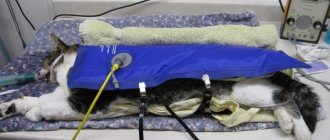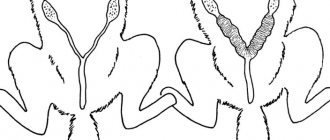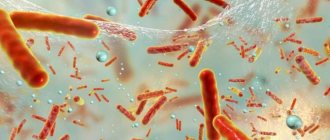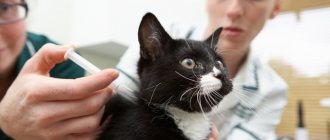In cats, spotting can be either normal or a sign of serious illness. In the first case, they accompany normal physiological processes, such as estrus or cleansing of the uterine cavity after childbirth. But if the discharge appears at the wrong time, causes discomfort to your pet and has a foul odor, you should consult a veterinarian as soon as possible. If this is not done, the animal may die.
So, how to distinguish normal discharge from pathological ones and how to treat a cat?
Reasons for appearance
Normally, bloody discharge appears in a cat for the following reasons:
- Estrus. The discharge indicates that the cat is ready to mate and bear offspring; its duration is several days. At the same time, the secretion does not have an unpleasant odor, and when the animal licks itself, it does not leave marks on surrounding objects. It is important to remember that spotting during estrus is typical for untied cats. After the first birth they will always be transparent.
- During pregnancy. Normally, during the entire period when a cat is bearing offspring, she should not be bothered by discharge. Ichor may be released during contractions.
- After the birth of kittens. The animal’s body is recovering, so during the first three weeks after birth, the presence of spotting is considered normal. In this case, the pet should feel well, eat as usual and carefully care for the offspring. If the discharge continues for more than the specified period, and the cat becomes lethargic, then it needs to be shown to a veterinarian.
A small amount of blood from the uterus can be released in cats only for the reasons described above. If the secretion is copious, foul-smelling, or includes particles, then this may be a symptom of many diseases of the genitourinary system or a sign of uterine bleeding.
Signs of bleeding
The occurrence of external bleeding is beyond doubt.
- outflow of scarlet blood in a small volume when a capillary is damaged;
- a scarlet pulsating stream during arterial bleeding;
- discharge of dark blood during venous bleeding.
In case of internal bleeding from organs communicating with the external environment, the owner of the affected animal may notice:
- secretion of scarlet blood with the animal’s saliva;
- vomiting, in which the vomit resembles thick coffee or chocolate;
- the appearance of blood in the stool;
- black stools that look like tar (a sign of bleeding from the upper digestive system);
- the presence of blood in the urine.
If bleeding begins in organs that do not communicate with the external environment, the animal’s suffering can be noticed only by indirect signs:
- violation of general condition;
- increased body temperature;
- severe shortness of breath;
- increased pet fatigue;
- pallor of visible mucous membranes;
- rapid increase in abdominal volume.
Hidden bleeding is very dangerous because it is often detected too late. Arterial ones are scary because death occurs within a few minutes, without competent help.
Dangerous diseases
Cats may experience atypical bloody discharge, which is a symptom of the following diseases:
- endometritis and pyometra are infectious diseases in which the uterine mucosa becomes inflamed and begins to bleed;
- inflammatory processes in the genital organs - their causes are varied, ranging from stress to infection, often ending in cystitis;
- phlegmon - under the influence of unfavorable factors, the cat experiences swelling of the genitals and the formation of ulcers;
- vaginitis - inflammation of the vagina caused by infections or injuries after unsuccessful medical procedures;
- tumor process in the uterus - as a rule, it is malignant in nature, the animal experiences destruction of soft tissues;
- placenta in the uterus - if not all placenta came out during childbirth, this leads to an inflammatory process in the uterus;
- various injuries to the genital organs - most often the cause is a poorly performed operation, which leads to bleeding.
The diseases described above have many similar symptoms:
- the animal becomes lethargic and drowsy;
- the cat tries to hide from its owners and other pets and shows no interest in playing;
- food refusal is observed, the animal may not drink well;
- a secretion is released from the genital organs, which, depending on the pathology, can be foul-smelling, with traces of pus and particles of mucous membrane;
- blood loss continues for a long time without a tendency to stop;
- The animal's temperature rises and does not subside.
To find out what exactly your pet is sick with, you need to contact a veterinarian as soon as possible. Independent attempts to find out what exactly is happening with the cat will not only not lead to success, but will also lead to the loss of precious time.
What to do?
If you suspect an illness, you should not hesitate. Some infectious diseases and uterine bleeding develop very quickly. No self-medication is inappropriate here. There is also no point in calling a specialist to your home - without tests and diagnostics, it will still not be possible to establish a diagnosis.
The cat must be taken to a veterinary clinic and examined. After which the veterinarian makes a diagnosis and prescribes treatment.
In many cases, bloody discharge in a cat is a physiologically normal phenomenon that does not require outside intervention. This is common during estrus, just before birth, and the postpartum period. Intense bleeding in other cases may be associated with the development of severe diseases of the genital organs and bladder.
Treatment
Before starting to treat the animal, the doctor finds out the root cause of the discharge. This will require the following examinations:
- initial examination of the animal, careful palpation of the abdominal area;
- general and biochemical blood test, laboratory urine test;
- Ultrasound of internal organs;
- examination of the uterus using a colposcope;
- study of secretions;
- bacterial culture to identify the pathogen;
- biopsy of the mucous membranes of the genital organs.
Based on the research results, the doctor makes a diagnosis and prescribes the necessary medications and procedures.
Depending on the reason for the bleeding, the cat is prescribed the following treatment:
- Anti-shock therapy is carried out using painkillers.
- If your cat is bleeding heavily, a blood transfusion may be required.
- If the bleeding is caused by low blood clotting, then corrective therapy is prescribed.
- For pathologies such as tumors or endometritis, surgery followed by chemotherapy is indicated to reduce the risk of relapse.
- The animal is prescribed antibiotics when the disease is caused by pathogenic microorganisms.
All medications and their dosage can be prescribed and adjusted only by a veterinarian. Self-medication will not only not bring a positive result, but can also lead to the premature death of your pet.
Signs of bleeding
The occurrence of external bleeding is beyond doubt.
- outflow of scarlet blood in a small volume when a capillary is damaged;
- a scarlet pulsating stream during arterial bleeding;
- discharge of dark blood during venous bleeding.
In case of internal bleeding from organs communicating with the external environment, the owner of the affected animal may notice:
- secretion of scarlet blood with the animal’s saliva;
- vomiting, in which the vomit resembles thick coffee or chocolate;
- the appearance of blood in the stool;
- black stools that look like tar (a sign of bleeding from the upper digestive system);
- the presence of blood in the urine.
If bleeding begins in organs that do not communicate with the external environment, the animal’s suffering can be noticed only by indirect signs:
- violation of general condition;
- increased body temperature;
- severe shortness of breath;
- increased pet fatigue;
- pallor of visible mucous membranes;
- rapid increase in abdominal volume.
Hidden bleeding is very dangerous because it is often detected too late. Arterial ones are scary because death occurs within a few minutes, without competent help.
Care, maintenance and treatment of your pet
In order for treatment measures to bring positive results more quickly, owners need to provide the cat with proper care:
- Provide a secluded place for the animal, put a disposable sheet on the bed and change it regularly when it gets dirty.
- The room where the sick cat is located must be warm and free of drafts, and it must be ventilated regularly.
- During treatment, it is forbidden to let your pet go outside; its communication with other pets should be limited.
- The cat must have constant access to drinking water. If the animal refuses to drink or is too weak, you need to give it water yourself using a syringe, after removing the needle.
- During the illness, the animal should receive nutritious and easily digestible food. These can be meat broths, to which chopped meat, fermented milk products, cereals and vegetables are added in small quantities. On the advice of a veterinarian, you can purchase special medicated food so that the animal gains strength faster.
To protect your pet from diseases that lead to bleeding, you must adhere to the following preventive measures:
- If the cat is not intended for breeding, it makes sense to sterilize the pet. This will protect her from many diseases that occur in the genitourinary system. After the procedure, the cat should be regularly shown to the veterinarian for an ultrasound, this will help to better monitor the animal’s health.
- Get all necessary vaccinations and antihelminthic treatment in a timely manner to maintain the body's defenses.
- For mating, choose a healthy male cat; the owners of the male must document this.
- When giving birth to a cat, use sterile consumables and thoroughly treat your hands with antiseptics.
- If any unusual discharge occurs, you should take your cat to the veterinarian as soon as possible.
The measures described above will help not only prevent the development of the disease, but also, if necessary, show the cat to a specialist as soon as possible without wasting time.
Bloody discharge accompanied by a significant deterioration in the animal’s condition is a formidable sign indicating the development of severe pathology. There is no need to try to find the cause on your own, but take the cat to the veterinary clinic as soon as possible for examination and treatment.
After mating
Bloody discharge from the loop may appear in a cat after mating in the event of resorption of the fetus, which can occur at any stage of pregnancy. In most cases, the animal’s body independently copes with the problem , expelling the dead fetuses from the womb, but they can also remain in the uterus for quite a long time.
As a result, fruit rot begins, which can lead to inflammation of the cat’s genitals and blood poisoning. Resorption of the fruit is accompanied by bleeding with pus and mucus. Blood clots have a rather pungent odor.
A possible cause of bleeding after mating can also be an ectopic pregnancy. In this case, urgent assistance from a veterinarian is necessary—delayed surgical intervention can lead to the death of the pet.
What kind of discharge in cats is considered unhealthy?
White
- Inflammatory process in the genitals, white discharge from the loop. It is a consequence of hypothermia or infection. The cat licks under its tail. Frequent urination. When pathogenic bacteria reach the bladder, cystitis develops. Walking your pet and being in drafts is prohibited. Self-medication is ineffective. It is possible to prescribe the necessary medications only with a urine test.
- Serous vaginitis is an inflammation of the vaginal walls. Typical of organ injuries received during lambing. Possible as a complication of previous diseases. This occurs after taking antibiotics due to a disturbance in the microflora.
White vaginal discharge may indicate serous vaginitis
Purulent
- Cancer of the genital and reproductive organs. The cat is losing weight for no reason and is indifferent to food. Fluid regularly accumulates under the tail. The pet stops taking care of herself. Looks sloppy.
- Catarrhal-purulent vaginitis. Inflammation of the vaginal walls, complicated by an abscess. A viscous and cloudy exudate is observed.
- Vaginal phlegmon. Swelling of the vulva and pubis, accompanied by abscesses. Pus and mucus come out.
- Pyometra is a purulent inflammation of the uterine mucosa. It occurs against the background of hormonal imbalance, provoked both by the consumption of drugs that reduce sexual activity, and by advanced endometritis. The individual is not active and looks depressed. The most dangerous is the closed form. No pus is released. The state of health deteriorates sharply, which is why failure to see a doctor can lead to death.
Any purulent discharge has an unpleasant odor.
Bloody
Blood tests may indicate cancer or damage to internal organs
- Oncology of urogenital organs. Accompanied by the discharge of pus when the general condition worsens.
- Decomposition of the placenta with incomplete delivery of the placenta. The cat feels unwell, feels weak, does not eat, and may bleed from the anterior passage. Body temperature rises. Delay is fraught with peritonitis. The patient needs urgent surgery (cleaning) in a clinical setting.
- Damage to the uterus associated with careless surgery, especially in neutered cats. Blood flows from under the tail. The victim needs to create the most comfortable conditions possible: arrange a resting place in a room where no one will disturb the peace. It is not possible to determine harm on your own. Improper transportation is life-threatening. It is necessary to call a veterinarian to your home to examine and take appropriate rescue measures.
- Endometritis is inflammation of the lining of the uterus. It is provoked by infections, as well as by taking medications that suppress attraction to the opposite sex. The discharge is strong and spotting.
- Threat of miscarriage. Bleeds between the fourth and eighth weeks.
- Blood clotting disorder. Leads to the release of characteristic bloody clots and red liquid.
All of the above facts require contacting a veterinarian. It is possible to prescribe a course of treatment only after conducting research: examination, ultrasound, urine tests, blood tests, smears.
Bleeding in a cat is the process of blood leaking from the bloodstream due to damage to the walls of blood vessels. The body of a healthy animal copes with a single and minor bleeding on its own in the shortest possible time, launching a protective process in which the vascular contraction reflex is triggered. Compressed vessels clot blood in places of damage, clogging them, and thereby stopping blood loss. Regular bleeding is very dangerous for your pet.
Bleeding due to vaginitis
Bleeding disorders due to non-communicable diseases can also be accompanied by bleeding. In this case, laboratory tests will be needed: ultrasound of the liver.
Remember, bleeding from the mouth is a serious sign. If it is not caused by a minor injury to the oral cavity (lips, gums, teeth), then you should immediately consult a veterinarian.
We know very little about the time of the appearance of the first domestic animals; there is practically no confirmed information about them. There are no legends or chronicles preserved about that period of human life when we were able to tame wild animals. It is believed that already in the Stone Age, ancient people had domesticated animals, the ancestors of today's domestic animals.
Scientists assume that every domestic animal has its wild ancestor. Proof of this is archaeological excavations carried out on the ruins of ancient human settlements. During excavations, bones were found belonging to domestic animals of the ancient world. So it can be argued that even in such a distant era of human life, domesticated animals accompanied us. Today there are species of domestic animals that are no longer found in the wild.
Many of today's wild animals are feral animals caused by humans. For example, let's take America or Australia as clear evidence of this theory. Almost all domestic animals were brought to these continents from Europe. These animals have found fertile soil for life and development. An example of this is hares or rabbits in Australia.
Due to the fact that there are no natural predators dangerous for this species on this continent, they multiplied in huge numbers and went wild. Since all rabbits were domesticated and brought by Europeans for their needs. Therefore, we can say with confidence that more than half of wild domesticated animals are former domestic animals. For example, wild city cats and dogs.
Be that as it may, the question of the origin of domestic animals should be considered open. As for our pets. The first confirmations in chronicles and legends we meet are a dog and a cat. In Egypt, the cat was a sacred animal, and dogs were actively used by humanity in the ancient era.
Domestic animals are divided into two unequal species.
The first type of domestic animal is farm animals that directly benefit humans. Meat, wool, fur and many other useful things, goods, and are also used by us for food. But they do not live directly in the same room with a person.
The second type is pet animals (companions), which we see every day in our houses or apartments. They brighten up our leisure time, entertain us and give us pleasure. And most of them are almost useless for practical purposes in the modern world, such as hamsters, guinea pigs, parrots and many others.
Animals of the same species can often belong to both species, both farm animals and pets. A prime example of this is that rabbits and ferrets are kept at home as pets, but are also bred for their meat and fur. Also, some waste from pets can be used, for example, the hair of cats and dogs for knitting various items or as insulation. For example, belts made of dog hair.
Many doctors note the positive impact of pets on human health and well-being. We can notice that many families who keep animals at home note that these animals create comfort, calm, and relieve stress.
This encyclopedia was created by us to help pet lovers. We hope that our encyclopedia will help you in choosing a pet and caring for it.
If you have interesting observations of your pet’s behavior or would like to share information about some pet. Or you have a nursery, veterinary clinic, or animal hotel near your home, write to us about them at , so that we can add this information to the database on our website.
We suggest you read: Childbirth in cats: childbirth, place for birth, feeding and care, veterinary care
Cats are very “loving” creatures, and therefore diseases of the reproductive system are not uncommon in them. As a rule, everything ends in “banal” endometritis, but more serious pathologies can arise. For example, uterine bleeding, which is quite capable of leading to death.
There can be a lot of predisposing factors; their groups are often combined, and therefore we will consider only the most common ones. So, one of the most common causes is injury.
Function of the pancreas
The pancreas in cats performs two functions at once. It is an endocrine organ that produces hormones that regulate body functions. And also the exocrine organ is a source of enzymes necessary for digesting food in the stomach.
There are many problems with the proper functioning of the pancreas that can occur in animals. The endocrine part may fail to produce balanced hormones. The most common example is diabetes. In this case, the pancreas does not produce enough insulin.
There are also a lot of common diseases caused by problems with the exocrine part. The pancreas may stop producing the required amount of enzymes, which in turn will cause a condition called exocrine pancreas insufficiency. In this case, the pancreas becomes inflamed due to the fact that enzymes that should enter the digestive tract remain in the gland itself and begin to corrode it from the inside. This causes bleeding from the cat's anus.
Mechanical injuries, infections, parasites, and idiosyncratic reactions to certain medications are most often cited by doctors as the most likely causes of the disease. But there is still no clear consensus on what causes pancreatitis in cats.
The majority of disease cases ({amp}gt;90%) cannot be caused by just one specific cause. The risk of pathology is higher in Siamese cats, as they are more predisposed to it at the genetic level.











